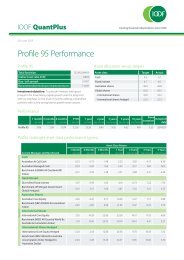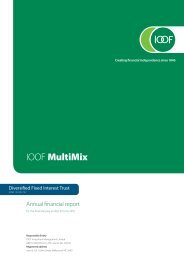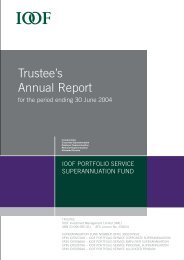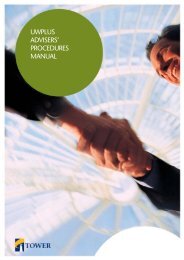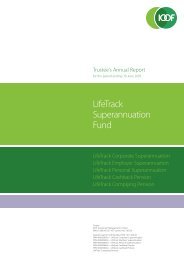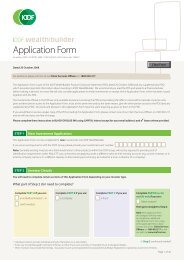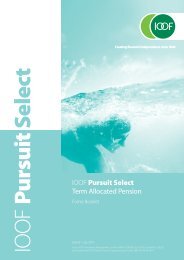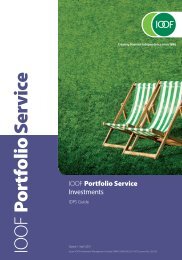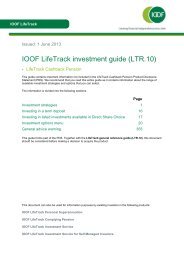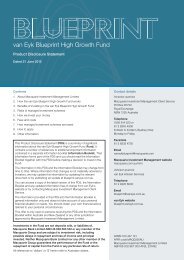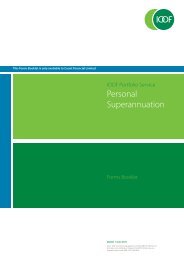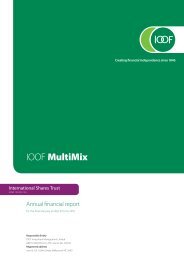annual report 2011
annual report 2011
annual report 2011
Create successful ePaper yourself
Turn your PDF publications into a flip-book with our unique Google optimized e-Paper software.
IOOF | <strong>annual</strong> <strong>report</strong> <strong>2011</strong><br />
(d) Life insurance risk<br />
During the financial year the Group was exposed to life<br />
insurance risks through the subsidiary IOOF Life Ltd. These<br />
risks related to pricing, acceptance and management of<br />
mortality, morbidity and longevity risks from policyholders.<br />
The life policies of IOOF Life Ltd were transferred effective 1<br />
September 2010 to Tower Australia Ltd. The Group had no<br />
exposure to life insurance risks as at 30 June <strong>2011</strong>.<br />
Insurance risks were controlled through the use of<br />
underwriting procedures, adequate premium rates and policy<br />
charges, and sufficient reinsurance arrangements; all of which<br />
were reviewed by the Appointed Actuary. Tight controls were<br />
also maintained over claims management practices to ensure<br />
the correct and timely payment of insurance claims.<br />
Financial risks were monitored and controlled by selecting<br />
appropriate assets to back policy liabilities. The assets were<br />
regularly monitored by the Investment Committee to<br />
ensure there were no material exposures and that liability<br />
mismatching issues and other risks such as liquidity risk and<br />
credit risk are maintained within acceptable limits.<br />
Refer to Note 40 Life Insurance Business for further details.<br />
The Group’s insurance operations are subject to regulatory<br />
capital requirements which prescribe the amount of capital<br />
to be held depending on the type, quality and concentration<br />
of investments held. Procedures are in place to monitor<br />
compliance with these requirements.<br />
(e) Fair value estimation<br />
The fair value of financial assets and financial liabilities must be<br />
estimated for recognition and measurement, or for disclosure<br />
purposes.<br />
The fair value of financial instruments traded in active markets<br />
is based on quoted market prices at the <strong>report</strong>ing date. The<br />
quoted market price used for financial assets is the current bid<br />
price.<br />
The fair value of financial instruments that are not traded in an<br />
active market (such as share buy-back liabilities) is determined<br />
using valuation techniques. Valuation models have been<br />
established in consultation with professional accounting firms,<br />
using generally accepted valuation methodologies. These<br />
include estimated discounted cash flows. Certain assumptions<br />
are made that are based on market conditions existing at each<br />
balance date. Assumptions used included terminal growth<br />
rates of 5% which do not exceed the long-term average<br />
growth rate for each of the businesses and pre-tax discount<br />
rates in the range of 13-16%. The estimated fair values<br />
resulting from the valuation techniques are reasonable and the<br />
most appropriate at the balance date.<br />
For details regarding the fair value of available-for-sale assets<br />
and assets carried at fair value, refer to Note 14 Other financial<br />
assets.<br />
The carrying value of receivables, net of impairment provisions,<br />
and payables are assumed to approximate their fair values due<br />
to their short-term nature.<br />
Loans and other receivables are carried at amortised cost using<br />
the effective interest method and closely approximate their<br />
estimated fair value. Refer to Note 14 Other financial assets for<br />
further details.<br />
Units in unlisted trusts are carried at the current unit price for<br />
redemption of those units with the trust.<br />
page 73



